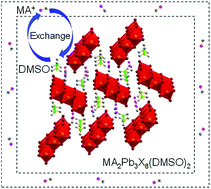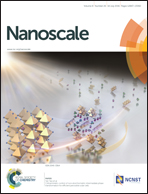Critical kinetic control of non-stoichiometric intermediate phase transformation for efficient perovskite solar cells†
Abstract
Organometal trihalide perovskites (OTP) have attracted significant attention as a low-cost and high-efficiency solar cell material. Due to the strong coordination between lead iodide (PbI2) and dimethyl sulfoxide (DMSO) solvent, a non-stoichiometric intermediate phase of MA2Pb3I8(DMSO)2 (MA = CH3NH3+) usually forms in the one-step deposition method that plays a critical role in attaining high power conversion efficiency. However, the kinetic understanding of how the non-stoichiometric intermediate phase transforms during thermal annealing is currently absent. In this work, we investigated such a phase transformation and provided a clear picture of three phase transition pathways as a function of annealing conditions. The interdiffusion of MAI and DMSO varies strongly with the annealing temperature and time, thus determining the final film composition and morphology. A surprising finding reveals that the best performing cells contain ∼18% of the non-stoichiometric intermediate phase, instead of pure phase OTP. The presence of such an intermediate phase enables smooth surface morphology and enhances the charge carrier lifetime. Our results highlight the importance of the intermediate phase growth kinetics that could lead to large-scale production of efficient solution processed perovskite solar cells.


 Please wait while we load your content...
Please wait while we load your content...